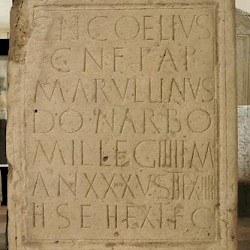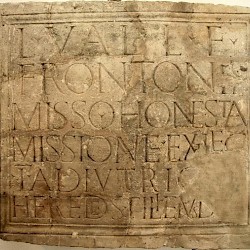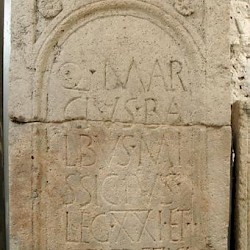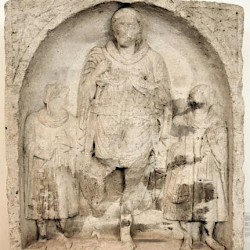Mainz, Selected Military Tombstones
Mogontiacum: Roman city, capital of Germania Superior, important military base, modern Mainz.
Selected Military Tombstones
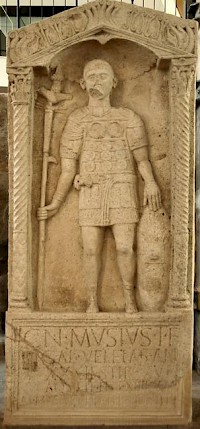
On this page, you will find photos of the tombstones of several soldiers, all from the Landesmuseum, where the Mainz Pedestals, Jupiter Column, and the Arch of Victor are also on display.
The history of Mainz can partly be deduced from the inscriptions on these tombstones, which prove that ancient Mainz was in the first place a military base. At the time of the Battle in the Teutoburg Forest (9 CE), the First Legion Germanica and the Fifth Alaudae were staying in Mainz. After the battle, they were replaced by XIV Gemina and XVI Gallica.
XIV Gemina, XVI Gallica, and reinforcements (9-39 CE)
The first photo shows the tombstone of Gnaeus Musius, standard bearer of the Fourteenth. Musius' tombstone shows him with the standard (the "eagle"). He died at the age of 32 after fifteen service years.note
The first photo in the gallery below shows the tombstone of a soldier of the Sixteenth Legion who was called Titus Pompeius and was born in Viana, a town in Raetia.note As was usual, the text is largely made up from abbreviations that every literate Roman would have understood. A spelling error like "eres" instead of "heres" (heir) in the fifth line informs us about the pronunciation of Latin in Roman Mainz.
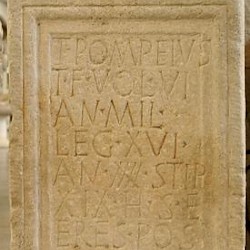 Mainz, Tombstone of Titus Pompeius of XVI Gallica |
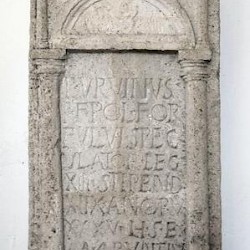 Mainz, Tombstone of Urvinus of XIII Gemina |
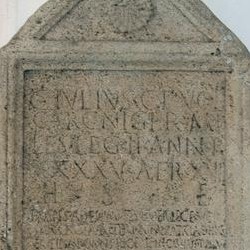 Mainz, Tombstone of G. Julius Niger |
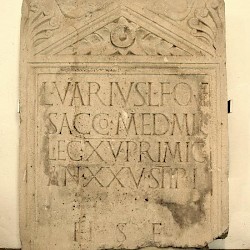 Mainz, Tombstone of L. Varius Sacco |
Titus POMPEIVS
Titi Filius VOLtina tribv VI-
ANa MILes LEGionis XVI
ANnorum XXXX STIPendiorum
XIX Hic Situs Est hERES POSu
IT MVNIC-
EPS
Which means:
Titus Pompeius, son of Titus, of the Voltinian district, born in Viana, a soldier of the Sixteenth Legion, forty years old, in his nineteenth year of service, is buried here. His heir and fellow-citizen erected this monument.
As a soldier of the Sixteenth, Pompeius must have experienced the hard years after the Teutoburg ;Forest disaster. Sometimes, reinforcements from other units were needed. The second photo in the gallery above shows the tombstone of a scout from the Thirteenth Legion Gemina called Publius Urvinus.note Under normal circumstances, this unit was stationed in Augsburg (on the Upper Danube) or Windisch (south of the Upper Rhine). The man must have seen action in Slovenia and Hungary. He died in his eighteenth year as a legionary, while serving as reinforcement of the Fourteenth and Sixteenth in Mainz. Was he killed in action?
The third photo in the gallery above shows is the tombstone of a soldier of the Second Legion Augusta named Gaius Julius Niger.note He was born in Gaul, joined the army on the Iberian peninsula and must have served in the recently pacified area called Cantabria before his unit was sent to Mainz to support XIV Gemina and XVI Gallica in the years after the disaster in the Teutoburg Forest. It is known that II Augusta took part in the retaliatory campaigns conducted by prince Germanicus, the son of Drusus, founder of Mainz.
During these campaigns, sometimes no less than four legions were staying in Mainz. A second legionary base was therefore founded at the Weisenau, four kilometers south of the first base. It remained in use during the first century, although it was often used by auxiliary troops, and not legionaries.
XIV Gemina and XV Primigenia (39-42 CE)
The opposite bank of the Rhine was occupied by a tribe known as Chatti. In 39 CE, the emperor Caligula decided to attack them. According to our sources, Caligula's campaigns were not really important, but archaeological finds suggest otherwise. Two new legions were founded, the Fifteenth and Twenty-Second Primigenia. The Fifteenth Legion was added to XIV Gemina (hence the number). Lucius Varius Sacco of Milan in northern Italy, whose tombstone is the fourth one on the gallery above, was one of the recruits.note He died in Mainz after only one year of service, which almost certainly means that he was killed in action. He was twenty-five.
IIII Macedonica and XXII Primigenia (42-70 CE)
In the winter of 40/41, Servius Sulpicius Galba (the future emperor) overcame the Chatti, which lessened the tensions. Two years later, when the emperor Claudius invaded Britain, there was a new reshuffling of units, and both legions of Mainz were replaced. The new units were IIII Macedonica and the recently founded XXII Primigenia.
The first photo in the second gallery is the tombstone of Gnaeus Coelius Marullinus, born in Narbo in southern France.note He died before the Roman armies disgraced themselves in the winter of 69/70. One year before, the emperor Nero had committed suicide and had been succeeded by Galba; but the commander of the Rhine army, Vitellius, had revolted. The garrison of Mainz supported him and joined his march on Rome. At that moment, however, the Batavians revolted. Because the garrisons were depleted, they were able to conquer parts of the Rhineland and the city of Mainz was captured by other rebels. The legionary base itself, situated on the Kästrich hill, was besieged but remained in Roman hands.
In 70, order was restored by Quintus Petillius Cerialis, a relative of Vitellius' enemy and successor Vespasian, and Mainz was fortified. The new troops were the recently founded I Adiutrix and (again) XIV Gemina.
I Adiutrix, XIIII Gemina, and Reinforcements (70-89 CE)
The second tombstone in the second gallery dates to the decade after the reconquest of the Rhineland. The soldier, Lucius Valerius Fronto, must have been a marine from Misenum in Italy first, because his unit is known to have been conscripted from naval soldiers. He was honorably dismissed before the legion was transferred to Hungary.
Although order had been restored in the Rhineland, the frontier was not safe yet. In 83, the emperor Domitian, a son of Vespasian, subdued the Chatti on the east bank. The Mainz Pedestals belong to this period. One of the legions that was in these years added to the garrison of Mainz was XXI Rapax, which arrived from Windisch in Switzerland. Quintus Marcius Balbus (third tombstone above) and his son Celer did not survive his stay in Mainz.
After this war, the Romans occupied positions on the east bank, where they started to build the Taunus limes. Mainz no longer was a frontier city and continued to grow. Domitian reorganized the military zone and gave it the status of a province, which was called Germania Superior. Mainz became its capital and the seat of the governor. However, the emperor was not successful in finding a good representative, because in 89, governor Lucius Antonius Saturninus revolted. The rebellion was soon repressed.
XXII Primigenia (after 89 CE)
The rebellious legions were transferred and Mainz received a new unit: XXII Primigenia, which had already been in the city before. Gaius Faltonius Secundus was one of the legionaries. He was born in Liguria, served for twenty-one years, and died at the venerable age of forty-six. He is shown on the fourth photo above with two servants or slaves.note
The Twenty-Second never left Mainz, and was - after a century in which the city had been occupied by two legions - the only unit. (The reference to a Sixth Legion Gallicana in the Historia Augustanote is almost certainly incorrect.) It comes as no surprise that in the second century, the inscriptions of Mainz are predominantly made for citizens. The city rapidly lost its military nature and military inscriptions become relatively rare.
